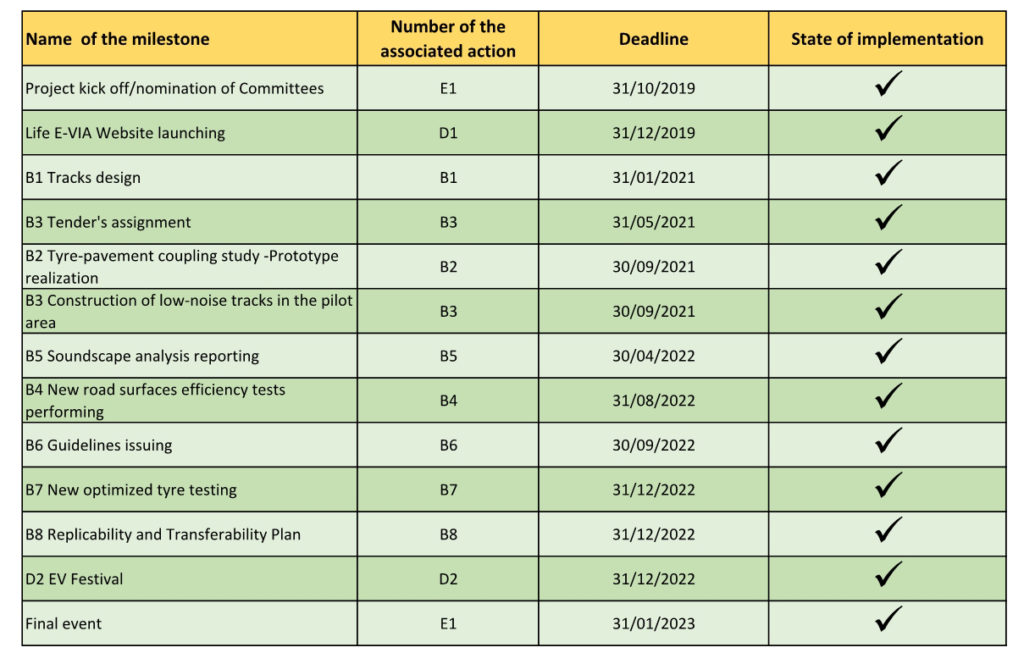Progress and Key Results
In this section the progress and results achieved are depicted through simple graphical tools and tables. Details on activities and deliverables are available in Documents.
Key Results
Key results obtained according to project’s objectives and expected results
- A complete literature review on EVs and their noise emission (Link Report A1), on the best scientific and practical bases to design the tracks including in-lab tests (Link Report A2), and on the role of the tyre in the context of EV vs. ICE vehicles (ICEV) with respect to rolling noise and related target conflicts (Link Report A3) has been carried out.
For more information click here: Report A1, A2,A3
- More than 150 solutions for bituminous mixtures have been analyzed. Then 9 mixtures have been selected according to acoustic response (as built and over time), expected life by referring to mechanistic properties, permeability, friction, satisfactory expected life, ENDt (Estimated Noise Difference Due to Texture) value sufficiently low. Based on additional considerations, 2 mixtures (with and without Crumb Rubber – CR) have been designed for further testing.
For more information click here: Report B1
- A mitigation measure aimed at optimizing road surfaces and tyres of EVs to reduce noise for roads inside very populated urban areas has been developed. Two road surfaces, 5 different EV types, one reference ICEV and 6 tyre versions per vehicle type (including tyres specifically designed for EVs) have been tested. Specifically, in Nantes two versions (with and without crumb rubber) of the final prototype developed by UNIRC partner have been tested by UNI-EIFFEL partner. Finally, the prototype with crumb rubber has been laid in the pilot case in Florence.
For more information click here: Report B2
For more information click here: Report B3
- LCPX measurements were carried out by I-POOL partner during the last year, from October 2021 to October 2022 to assess the behaviour of the pavements right after they were laid and with a significant traffic load. This parameter is measured nearby the contact point between a special reference wheel and the road, essentially evaluating the noise contribution of the road alone, so not including other possible noise sources as the engine or the exhaust pipe. The Green Public Procurement Criteria for Road Design, Construction and Maintenance issued by the European Commission gives some reference value that newly laid pavements have to observe to reflect higher environmental standards that the EU is striving to achieve, firstly to directly benefit its citizens: a 93 dBA reference value is imposed for LCPX road emission at 50 km/h within its first 5 years of duty. The last measurement session gave the following results for the E-VIA pavements: 90.4 dBA (with 1 dBA uncertainty) for the reference pavement and 89.3 dBA (with 0.9 dBA uncertainty) for the E-VIA pavements that includes crumb rubber, giving a further environmental advantage in the recycle and reuse of exhausted tyres. Ageing effects were observed in subsequent testing sessions.
- The sound absorption was studied by I-POOL with a sampling of both center lane and wheel track of the reference and the new pavement. This allowed to evaluate the homogeneity of the layings and, by repeating the tests for a year, the changing behaviour induced by the ageing process. Both employed techniques confirmed the low absorption of the pavements accomplishing the design expectation and reported a slight reduction over time, probably due to surface pore clogging and compaction of the material.
- CPB measurements were carried out by I-POOL for making a comparison of the performance of vehicles and tyres combination, turning out to be very useful in terms of noise emission. Due to the fact that the two pavements were one after the other, passages could be measured consecutively reducing the error space, weather conditions and repeatability. In wide band, the E-VIA pavement is 2.1 dB(A) less noisy that the reference pavement.
- To assess the benefits of the use of the optimized asphalt the following activities were carried out by VIENROSE partner in the pilot area: (i) soundwalks and binaural listening of audio recordings inside a vehicle, (ii) interviews on an electric vehicle, (iii) ante and post-operam interviews with residents. Results show a positive assessment of the optimized asphalt performance. In particular, 30% of the subjects evaluated the soundscape inside an EV passing on the optimized asphalt as “good” while the percentage is just 10% as regards the sound perceived inside and ICEV and an EV crossing a stretch with standard asphalt. Also, 70% of the interviewees inside the electric taxi indicated the optimized asphalt as the one with the best performance in terms of acoustic comfort, compared to new but standard asphalt and the worn one. Survey administered to residents, living in the street section repaved with the optimized asphalt, demonstrate that the intervention improved the quality of the soundscape and reduced the perceived traffic noise: according to 61% of the respondents traffic noise has decreased after the intervention and 77% assessed the intervention as positive.
- According to acoustic measurements carried out at receivers roadside by VIENROSE and I-POOL about one year after the intervention implementation, a reduction of 4.4 dB(A) in terms of Lnight (in the night period from 10 p.m. to 6 a.m.) has been measured. This benefit affects about 2.000 residents of the pilot area. About 16 months after the pilot intervention realization, a new noise measurement campaign has been carried out in order to verify asphalt performances overtime. Between the second and the third noise measurement campaign, a difference of 2.9 dB(A) in terms of Lnight was still measured.
For more information click here: Report B5
- A new tool has been developed by I-POOL to evaluate the acoustic impact of a new kind of mobility, defined by the switching from internal combustion engine vehicles to electrical ones and supported by the laying of new kind of pavements that can guarantee very good noise emission performances alongside promoting the recycling of waste materials such as exhausted tyre crumb rubber. Its final aim is to promote the use of such new approaches for improving of the mobility and noise reduction, thus providing knowledge and tools to public administrations which deal with urban planning. In particular, experimental results obtained on the two test tracks laid in Florence were used for:
– calculating the rolling noise coefficients of the CNOSSOS model for EV for the reference road surface;
– estimating the road surface correction factor on rolling noise emission (ΔLWR,road) for the CNOSSOS model that takes into account the acoustic performance of the E-VIA pavement for the EVs;
– evaluating the acoustic benefit to the receivers offered both by an increasing percentage of EVs in the
circulating vehicle fleet and by the use of the E-VIA new road surface.
- Compared to state-of-the art premium summer tires, the noise optimized tyre for electric vehicles developed by CRD led to a reduction of rolling noise of 0.8 dB(A) under typical urban driving conditions. During the noise tests, the robustness of the provided noise optimisations was proven by relatively consistent noise reductions on a variety of road surfaces, at a different number of speeds, and using a number of different test vehicles. Especially good results were obtained with the two LIFE E-VIA surfaces tested in Nantes, highlighting the combined efficiency of the LIFE E-VIA solutions. The very good noise performance of the LIFE E-VIA tyre is combined with a very balanced and competitive portfolio of non-noise related performances. For the most important criteria the already very good performance levels of the reference tyre could be maintained, if not slightly improved. Especially, there was no negative impact on rolling resistance and wet grip performance, and even an expected increase in milage, which highlights the ecological, economical and safe design of the final tyre.
- Regarding the project website, more than 12.000 visits have taken place with more than 2.500 users interacting. Regarding socials, on the Facebook page more than 280 sessions have taken place as well as more than 100 sessions on the LinkedIn page. Moreover, more than 15 scientific papers have been published and more than 20 presentations have been given during conferences (about 900 people reached), together with more than 20 brief articles on Italian magazines mainly concerning the pilot case. An overall number of about 60 students has been directly informed about project activities.
For more information click here: Report C1
- A LCA and LCC analysis has been carried out by UNIRC.
For more information click here: Report C2
- Concerning replication actions, asphalts of the same type as those tested in the E-VIA project will be proposed by FIRENZE for infrastructures with similar characteristics to those of Paisiello street. Specifically, more than 25,000 m2 of asphalt with technical characteristics analogous to those of the E-VIA project will be laid in Florence in 2023. VIENROSE will propose the use of the optimised asphalt proposed by the LIFE E-VIA project to its customers, for whom contracts have already been awarded for the IV round of updating of the agglomerations’ Action Plans as the implemented database and the coefficients for electric vehicles and asphalt, processed and tested on Via Paisiello, will certainly be used in the IV Round of Action Plans. Moreover, a fourth round of CPX measurements will be carried out in 2024 by I-POOL/VIENROSE, to estimate the efficiency of pavements after 3 years of surfaces realization and UNI EIFFEL will monitor the CPX noise levels on the prototype in Nantes at least once a year during a period of 5 years after the project.
For more information click here: Report B8
For more information click here: AfterLife Plan
Gantt Chart

DELIVERABLES

MILESTONES






